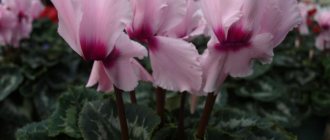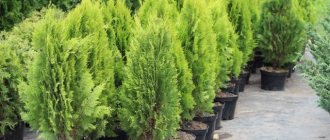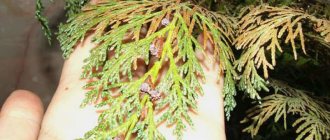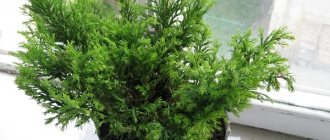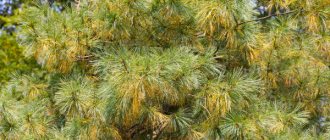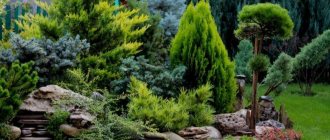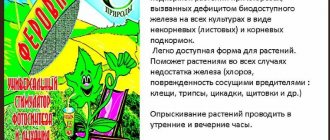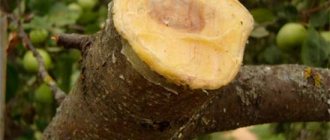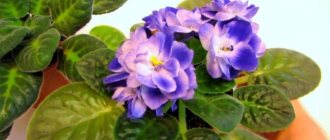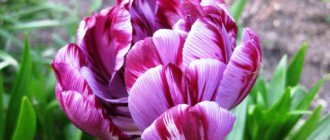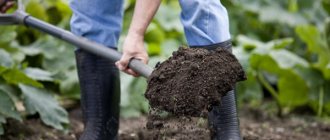Despite the fact that conifers are considered one of the most unpretentious ornamental plants in the garden, they often require the closest attention. Especially when they start to get sick. This can happen either to a young seedling that is weakened and cannot protect itself from fungi and pests, or to an adult tree that has suffered from improper care or insect infestation.
Therefore, it is necessary to regularly monitor whether the first symptoms have appeared and take appropriate treatment measures in a timely manner so that one case does not turn into a large-scale epidemic.
Classification of diseases
There is no single classification. There are many criteria by which diseases of ornamental coniferous plants are classified into a variety of groups.
Depending on age:
- damage to coniferous seedlings, seedlings and young trees (root rot, sclerotinia snow mold, verticillium wilt, late blight, etc.);
- damage to mature shrubs and trees.
Depending on the affected part of the plant:
- underground parts (root);
- needles, crowns;
- shoots, shoots;
- trunks, branches.
Depending on the specific type of conifer:
- fir necrosis, spruce necrosis;
- pine cancer, juniper cancer;
- pine shutte, spruce shutte, larch shutte, etc.
Depending on the reasons:
- bacterial and fungal diseases (infectious);
- non-infectious;
- due to pest damage.
There are diseases that affect only a specific species - pine or spruce, juniper or thuja. There are those that destroy only young seedlings and fresh shoots. Each of the classifications reflects a certain perspective of the problem that has arisen.
Fusarium
Seedlings and young coniferous plants are subject to Fusarium drying out, which is provoked by fungi of the genus Fusarium. Sometimes you can find such a name as tracheomycosis wilt. The main danger of fusarium is that it first affects the root system, which turns brown and rots, and then passes into the vascular system, filling it with fungus and preventing the access of nutrients. The needles turn yellow, red, become coarse and fall off, the tree weakens and gradually dries out. The main sources of infection are contaminated soil and planting material, as well as plant debris.
Measures for the prevention and control of fusarium
|
Non-communicable diseases
Vascular
Vascular diseases that affect coniferous trees have not yet been studied enough. It is only known that this condition is provoked by disturbances in the conduction system.
Signs: wilting of the entire plant or individual branches.
Treatment. Due to insufficient information about this group of diseases, there are no specific drugs. Enhanced care with the use of fertilizers is recommended, and general strengthening biostimulants cope with this better than others. It is important to prevent the development of any other diseases during this period, as this in most cases will lead to the death of the conifer.
Burns
The needles are extremely sensitive to sunlight. Especially during certain periods of a plant’s life: when it is sick, weakened, transplanted, or still very young. Most often this happens in February, when bright rays are reflected from the snow. Moreover, any glass surfaces of greenhouses and windows can work as a reflector.
The main symptom is browning, yellowing, or reddening of the needles, but only its top layer on a certain side.
Pine needles that have received sunburn cannot be saved. But this does not mean at all that you can give up on the plant. Resuscitation measures will allow it to recover faster, grow new shoots, and replace damaged needles with fresh ones. How to save?
- After the soil thaws, loosen the soil and fertilize it with mullein solution.
- Mulch the tree trunk circle with peat chips, crushed bark or pine litter.
- Trim branches that are completely damaged (that is, all the needles on them are burned).
- Spraying the crown with a mixture of Ferovit and Epin every 2 weeks.
- Pinch growing shoots to make the crown thicker.
- Enrich the soil with mycelium from the nearest forest.
To protect plantings from burns in the future, it is better to screen them in winter or put protection on them.
Withering
Conifers begin to get sick, wither and wither if they have to grow in unfavorable conditions or if their care is insufficient. In such cases, no traces of pest activity, no fungal growths, or sunburn can be found on them. However, the following will be observed:
- drying out of branches;
- yellowing of needles followed by falling off;
- lack of young shoots;
- stunting;
- loss of decorative properties.
Possible reasons for this condition:
- mechanical injuries (abundance of snow on branches, damage to bark by animals, chewing of needles by insects);
- deformed, pathologically diseased, underdeveloped root system;
- cracks in the bark formed after severe frosts;
- stagnant water, natural swamping, spring floods, excess soil moisture, rising groundwater levels;
- excessive density of plantings (fences made of coniferous trees, which begin to rot and rot in places of contact with each other, are especially often affected);
- improperly selected soil;
- lack of fertilizing in the form of fertilizer;
- incorrect or untimely processing of the crown;
- lack of preventive measures against insect pests.
An ornamental coniferous plant can become ill due to insufficient care or unfavorable growing conditions, as they will lead to metabolic and water balance disorders. In addition, all of the above factors weaken the immunity of trees and shrubs, and they become prey to fungi and insects.
Preventive actions
Preventing diseases and pests of conifers is much easier and more convenient than treating them. Diseases can affect any conifer, but with good care, illnesses occur much less frequently.
- To avoid the occurrence of diseases and infections, it is necessary to carefully select a site for conifers; the place should be well lit, with soil drainage, without waterlogging and groundwater passing close to the ground.
- It is recommended to plant conifers at a decent distance from each other so that they can grow quietly without shading their neighbors. Otherwise, even in a sunny area, individual plants will lack light.
- Once a year for planting, it is necessary to carry out sanitary pruning - remove all dry, broken and diseased shoots. A well-groomed, healthy tree is not as susceptible to attacks from diseases and pests and can resist their effects longer.
- It is recommended to use fungicidal and insecticidal agents not only for treatment, but also for preventive purposes. Since most fungal diseases and pests awaken immediately after the snow melts, conifers need to be sprayed in early spring, before stable warm weather sets in.
Important! Uncollected soil under the trunks of conifers with the remains of last year's needles is an ideal environment for the proliferation of fungi and insects. To protect the tree from diseases, the soil under it must be regularly cleaned and all collected debris must be burned.
Pest infestation
Insect pests should be classified as a separate group. They often become a real headache for gardeners, as they are capable of destroying all conifers on the site. Decorative exotic varieties that are not able to resist them, unlike the same forest pines, are especially at risk. The latter begin to produce abundant threshing, which floods the passages and nests of pests, thereby destroying them.
If the pests are not root or intra-trunk, they are usually easy to notice. Nests, cocoons, clutches of eggs, and larvae appear. The needles and branches are actively being nibbled. The process of destroying a tree or shrub usually occurs very quickly. Therefore, measures to combat insects must be taken immediately.
Treatment of insect pests is carried out with various drugs:
- antiseptic treatment;
- spraying with insecticides;
- intra-trunk injections (usually used to treat pine);
- spring and autumn treatment with preventive agents.
Pests are also dangerous because they contribute to the spread of fungal diseases on spores.
What diseases of conifers does Fitosporin help with?
Pine, thuja, spruce, yew, and larch trees grow well in summer cottages. Infections most often affect plantings in the spring, when the plants' immunity is weakened, as well as when crop farming practices are violated.
Shrubs and trees have a hard time with a lack of nutrition, flooding of the root system, and drying out of the soil. In such conditions, they get sick more often, look unattractive and sad.
Fitosporin is used as a means of prevention and treatment of the following diseases:
- Schutte (varieties of infection: real, snowy, brown). The infection is caused by an ascomycete fungus; cypress, thuja, sneakers, pine, and fir trees are more susceptible to infection. The needles turn yellow and then red, and black dots appear on the needles - the bodies of fungal spores. Young seedlings die especially quickly from shutte. How to use the drug? Diseased plants are treated with prepared tank mixtures, including Fitosporin. A solution for treating the soil is also prepared.
- rust. Pine and larch are affected. Infection often occurs from herbaceous plants (through raindrops, wind). Brown-yellow spots appear on the needles, and the same changes occur in breaks in the bark on the trunks. Treated with a biofungicide with the addition of Strobi and Kartotsid;
- Phytosporin for thuja is effective against gray mold and altenaria. Black or gray-brown spots appear on the shoots of bushes, the plant slows down in growth, dries out, and loses its decorative effect. Spray throughout the season (according to instructions), also thin out the crowns, remove deformed and diseased branches;
- Root rot and fusarium are caused by soil pathogenic fungi. Sign: redness and shedding of needles. In almost all conifers (fir, larch, spruce), changes begin from the middle tier of the crown, with the exception of pine (reddening of the needles occurs along individual shoots). The root system of plants rots, plants wither, young bushes often fall on their sides. Fitosporin solution is effective throughout the summer season (crown spraying, soil treatment).
For preventive purposes, the seeds are treated, and the roots of the seedlings are also soaked in a Fitosporin solution before planting. In addition to this drug, Vitaros and Maxim are suitable for soaking.
Fitosporin is a modern systemic biofungicide that helps prevent dangerous diseases of conifers and cure plants in the initial stages of infection.
Natalia Severova
Treatment methods
Despite such a variety of diseases, the treatment regimen in most cases is the same.
Removing diseased parts
The fight against disease begins with removing the affected parts, and every garden owner can handle this on their own:
- branches are carefully trimmed;
- the affected bark is removed (if it practically falls off by itself), and the bare area on the trunk is treated with garden varnish;
- yellowed needles are shaken off.
Any formations on conifers (fungal formations, settlements and nests of pests) are also removed mechanically. Everything that was collected from a diseased plant (from needles to insects) is immediately burned.
Medications
After this, treatment is continued using specific drugs. They need to be sprayed regularly, almost until complete recovery, on conifers. Fungicides - against fungi, insecticides - against those caused by pests, biostimulants - against non-infectious lesions.
Fungicides developed specifically for the treatment of fungal and bacterial diseases:
- the drug Rakurs is one of the most effective fungicides against rust and schutte, available in the form of powder and concentrated emulsion;
- Medea is a more universal remedy, not limited to any specific fungal diseases;
- Pokon - the drug is used for all diseases in which the needles turn brown or yellow;
- Sporagine Pine is a systemic biofungicide optimized for conifers.
Photo:
Insecticides developed to treat plants from diseases caused by pests:
- universal - from various insects (Pinotsid, Aktara, Karbofos - from aphids, sawfly, hermes);
- acaricidal - against ticks (Kleschevit, Nissoran);
- aficidal - from aphids (Biotlin);
- larvicidal - from larvae and caterpillars (Iskra, Lepidotsid, ExtraFlor);
- ovicidal - from eggs (Drug 30 Plus).
The most powerful insecticides are:
- Aktara;
- Aktellik;
- Antisheshelin;
- Bifenthrin;
- Vitalizer;
- Decis;
- Inta-Vir;
- Karbofos;
- Clipper;
- Creocide;
- Lepidocide;
- Neoron;
- Forsyth;
- Fury.
Photo:
For any diseases, you need to use biostimulants to generally strengthen the immunity and health of conifers. Some of the best are Zircon and Epin. You can also apply various fertilizers for this purpose:
- Aqua Agricola;
- Bona Forte;
- Hera;
- Green needle;
- Compo;
- Pokon;
- Reasil;
- Fusco;
- Fertika;
- Florovit.
Photo:
The drug chosen depending on the disease is used as soon as the first signs of damage are noticed. Spraying or root feeding is usually done in the evening or early in the morning, in calm and dry weather, using protective measures (special suit, goggles, etc.). The concentration is taken exactly as indicated in the instructions. Repeat treatment is usually carried out on 10, 14 or 21 days - this also depends on the manufacturer. If after two treatments the conifer still has not recovered, you need to either change the product or call specialists.
Related article: Fertilizers for coniferous plants
Folk remedies
Folk remedies can be used for medicinal purposes. They are budget-friendly compared to store-bought drugs. Almost all of them are universal, that is, they combine the properties of a fungicide, an insecticide, and a biostimulant.
However, you need to understand that they are not so effective, they do not always hit the target, and sometimes it happens that they harm the plants themselves. Therefore, extreme caution should be taken with them. These include:
- concentrated solutions of potassium or laundry soap;
- citrus infusion;
- tobacco infusion;
- wood ash;
- garden varnish prepared according to a home recipe;
- processing the trunk with clay with manure and ash or slaked lime.
There are also products that cannot be clearly classified as store-bought drugs or folk recipes. These are chemical active substances that are purchased separately, and then various mixtures, concentrates and solutions are prepared on their basis. They do not treat any specific diseases of conifers, but they cope with most of them. These include: Bordeaux mixture, copper sulfate, colloidal sulfur.
Conifer diseases and their treatment
Most conifer diseases are of fungal origin and are very dangerous for plants. Symptoms of some illnesses can be noticed immediately, while others appear only after time. In order not to miss warning signs, the gardener needs to know photos and descriptions of conifer diseases.
Schutte
The disease called Schutte exists in several varieties; it is customary to distinguish between real, snow and brown Schutte. The disease affects pines and spruces, junipers and firs, as well as other conifers. The harmful fungus that causes the appearance of any shutte develops under the snow at temperatures above 0 ° C, and the symptoms of the disease appear in the spring or summer, after the snow melts.
Signs of Schutte are a gray-black coating on the needles and microscopic black dots on individual needles. Snowy, real and brown chutes are especially dangerous for young pines, spruces, junipers and other conifers. As the disease progresses, the needles of the conifers begin to turn yellow and brown, and then fall off.
To treat the disease, it is necessary to treat the plantings with Bordeaux mixture throughout the entire warm period, as well as fungicidal solutions, such as sulfur-lime decoction, Abiga-Peak, HOM. Sanitary pruning of affected branches and tillage of the soil are also necessary; the root zone requires mandatory treatment, since spores of the Schutte fungus develop precisely in the soil at the roots of conifers.
Rust
The fungal disease rust primarily affects pine and larch trees in summer cottages. The disease is characterized by the spring appearance of yellow-orange spots on tree needles, which over time acquire a brown color and begin to crumble.
In the early stages, rust disease can be treated with fungicides and Bordeaux mixture. It is better to remove and burn severely affected shoots of the plant. Healthy and slightly damaged branches of a coniferous tree should be sprayed with medicinal solutions throughout the season - 3 times with an interval of 15-20 days.
Pine spinner
As the name implies, the fungal disease mainly affects pine trees. Its effect is manifested in the fact that the lateral shoots of the plant become strongly bent, and the apical shoot dies. In this case, yellow-orange swellings arranged in chains appear on the needles. The development of the disease leads to the fact that the growth of the coniferous tree stops, and after some time the pine may die.
Treatment of the disease in the early stages is carried out with Bordeaux mixture or Fundazol, spraying is carried out twice per season. Particular attention should be paid to the treatment of young trees; pines that are less than 10 years old are often affected by spinner.
Fusarium
The disease of coniferous plants, fusarium and root rot, is caused by pathogenic fungal flora that develops in the soil at the roots. Fusarium is dangerous not only for spruce and pine trees, but also for larches and fir trees. Externally, the disease manifests itself in the fact that the needles of the trees acquire a red tint and fall off, and the middle part of the crown is mainly affected. Root rot often occurs in young trees.
Treatment of the disease consists primarily of treating coniferous trees with fungicidal preparations - Bordeaux mixture, phytosporin, alirin. It is also necessary to control the quality of the soil in an area with conifers; fusarium most often develops on waterlogged soil with poor drainage.
Alternaria blight
Alternaria fungus develops mainly on the trunks and needles of junipers and thujas. You can recognize it by blackish or dark gray spots on the shoots; these spots are colonies of the fungus and gradually spread throughout the needles, leading to the death of the plant. The disease most often appears on conifers that are forced to develop in insufficient light.
Thus, the best prevention of Alternaria disease is careful selection of a place for planting thuja or juniper. Diseased conifers must be treated with Bordeaux mixture, fast and pure flowers; spraying begins in early spring and is carried out monthly throughout the summer. Coniferous shoots affected by the disease must be removed, and the sections are treated with copper sulfate to prevent further spread of the fungus.
Bacteoriosis
The bacterial infection vascular bacteriosis poses a great danger to conifers. An unpleasant feature of the disease is that the needles do not change their color or become stained, but simply become duller, so the disease is often not noticed immediately. But, nevertheless, as the disease develops, the needles begin to fall off the branches abundantly at the slightest touch.
In order not to miss the symptoms of bacteriosis, it is recommended to inspect trees for disease damage more often. At the first symptoms, the soil is treated with Fundazol, after another 3 days - with Fitosporin, and a few days after that - with Zircon. As a rule, the use of antiseptic drugs allows you to save diseased conifers from death.
Biatorella cancer
A fungal disease does not affect pine needles, but the wood of evergreen plants. When infected with biatorella cancer, the bark of conifers first turns brown, then becomes covered with cracks and begins to dry out and die. In place of the dead areas of the bark, long elongated ulcers form, and then resinous fungal growths appear in their place. As the fungus develops, the needles turn yellow and fall off.
To notice the disease in time, you need to regularly inspect the trunk and shoots of the plant. At the first symptoms of biatorella cancer, treatment with Bordeaux mixture and proven fungicides is required; it is advisable to repeat this 2-3 times per season.
Nectria cancer
Another disease of conifers manifests itself in the form of numerous microscopic growths of red-orange color that appear on the surface of the trunk. Gradually, the growths become darker and dry out, the bark begins to die, and the needles turn yellow and fall off.
Treatment of the disease is carried out using preparations containing copper; the soil at the roots of coniferous trees must be thoroughly watered with fungicides. Since the spread of fungal spores comes from the roots, it is necessary to carefully monitor the cleanliness of the tree trunk circle and promptly remove branch cuttings, fallen pine needles and other debris.
Gray rot
A disease called gray rot, or mold, is characterized by the appearance of an ash-gray cobwebby coating on the needles. During its development, the fungus grows into the roots of conifers and quickly leads to tissue death and death. Gray rot is especially dangerous for young conifers that have not had time to grow stronger after being planted in the ground. Most often, the disease affects conifers growing on waterlogged soil with a lack of sunlight.
To treat gray rot, it is necessary to remove all affected parts of the conifer, and then treat the trunks and needles with Bordeaux mixture and Ferbam solution - twice with an interval of 12 days. To prevent the disease, it is necessary to monitor the level of soil moisture and promptly feed the conifers with potassium and phosphorus.
Drying branches
The disease mainly affects junipers, thujas and young pines, and symptoms are manifested by drying out of the bark on the tree trunk and the appearance of brown and black growths on it. The needles of the plants acquire a yellow tint and fall off, the shoots begin to dry out and bend.
Treatment of the disease is carried out by spraying conifers with fungicidal preparations and Bordeaux mixture. Since drying out of branches most often develops on conifers that grow too densely and receive insufficient sunlight, if necessary, the plants can be planted further away from each other.
Necrosis
The fungal disease mainly affects young conifers under 10-15 years of age. The main symptom of the disease is redness of the needles, and the needles do not begin to fall off immediately. The bark of conifers also takes on a reddish tint, and microscopic black growths form in its cracks.
With a moderate level of necrosis, diseased conifers can be treated with Bordeaux mixture and preparations with a high copper content.
Attention! If the plant is severely affected by necrosis, it is wiser to remove it, burn the remains and thoroughly treat the soil with fungicides; in this case, you need to focus on preventing infection of neighboring trees.
Spruce canker
The fungus, which mainly affects spruce trees, manifests itself in the form of abundant tarring on the shoots of the plant. Over time, dead areas appear in the tarred areas, then the bark becomes covered with cracks, and numerous ulcers, dry or wet, covered with thin brown hairs, form on the trunk.
When symptoms of canker cancer appear, the affected spruce shoots must be removed and burned. The soil under the roots of the plant is shed with fungicides, and the crown is treated with preparations containing copper. When ulcerative cancer is advanced, spruce trees often die, so plantings must be regularly inspected for infection.
Prevention
It is much easier to prevent the defeat of conifers than to treat them later. This can be dealt with by timely root feeding and root spraying:
- in the spring, immediately after the snow melts and warming reaches 6-7°C, biostimulants and mineral fertilizers will come in handy;
- April - application of fungicides;
- May - spraying with repellents or simply insecticides (they can be combined with fungicides);
- in summer, once a month - use fungicides and insecticides, even if conifers do not get sick.
How to treat conifers in the fall?
For prevention, this is quite a pressing issue. The health of the plant in the spring, after awakening, will directly depend on this. The fact is that pest eggs and fungal spores are quite frost-resistant. They often hide under the bark and calmly survive the winter, but become more active as the weather gets warmer. That's why it's important to destroy them before the tree or shrub goes dormant. The biofungicides Sporobacterin and Fitosporin, as well as insecticides developed based on chitin synthesis inhibitors (Lufox or Applewood), cope well with this task.
Ornamental conifers do not have minor diseases that do not require attention. Without timely measures taken, they may die. Therefore, it is so important to be aware of the most common ones, how they manifest themselves and what means to treat them. If you lack experience in this area, you can call a specialist. Nowadays there are many competent companies that provide maintenance to green spaces and organize arboriculture (a set of measures aimed at tree therapy).
Pests of conifers and their control
Fungal and infectious diseases are not the only enemies of conifers. Insects pose no less of a danger to trees, and to successfully combat them you need to know the pests of conifers in the photo and their treatment.
Hermes
A small insect called hermes is one of the most common and dangerous pests. The insect settles on the shoots of pines, junipers, spruces and any other conifers in entire colonies, lays eggs and feeds on tree sap. Hermes larvae damage the young buds of conifers, and over time the plant dies. You can suspect the presence of Hermes by the yellowing of the needles and the slowdown in tree growth; upon closer examination, microscopic insects, as if covered with a little fluff, and Hermes larvae will be found on the needles.
Pest control involves spraying conifers with insecticides - Aktara and Komandor. Spraying needs to be done several times a season, since the invasion of Hermes on conifers can occur at the end of June, in August and even in September.
Bark beetle
A dangerous pest of conifers is the bark beetle, which feeds on the wood of the plant. An unpleasant feature of the insect is that the bark beetle is quite difficult to notice; it lives and reproduces under the bark. Its primary colonization can only be indicated by sawdust that suddenly appears under the trunk of a conifer, but this symptom is easily overlooked. In the later stages, it is often possible to recognize the presence of a pest only when the conifer begins to lose vitality and turn yellow.
Therapeutic and preventive control of bark beetle involves treating conifers with insecticides - spraying is best done annually to prevent the appearance of the pest. In addition, a special pheromone trap can be hung on heavily affected conifers; it will attract a large part of the beetle population, and then the pests can be destroyed along with the dying conifers.
Spider mite
Microscopic spider mites are dangerous for conifers because they feed on their juices and also multiply very quickly. During a season, the mite can produce up to 8 colonies; in the absence of counteraction, the pest can quickly destroy a pine, spruce or juniper tree.
However, dealing with spider mites is quite easy. First of all, it is easy to notice on the branches of a plant; the pest entangles the shoots of the conifer with the finest white web. Control measures against the disease come down to regular spraying of conifers with acaricidal solutions - Actellik, Agravertin and others. Spraying must be done every 15-20 days.
Advice! Spider mites most often attack coniferous plants in dry and hot weather. If you maintain moderate moisture and regularly water the plantings, the appearance of pests and diseases can, in principle, be prevented.
Shchitovka
Scale insects are insects that mainly attack junipers, thujas and yews. The pest looks like a small beetle with a shiny brown shell-shield; it mainly affects shoots closer to the middle of the crown. Under the influence of the scale insect, the needles quickly become brown and fall off, and, in addition, the scale insect provokes curvature and drying out of the shoots.
The fight against scale insects is carried out with Admiral, Actellik and Fury. Since female scale insects lay larvae several times per season, spraying should be done 2-3 times during the summer, taking a break for 1-2 weeks.
Sawfly
Harmful sawfly insects prefer to settle on pine and spruce trees. The main danger is not adult insects, but numerous larvae that feed on pine needles and young shoots. Under the influence of a pest, the ephedra may completely lose its needles.
You can recognize the sawfly by the yellowing and shedding of its needles; upon careful examination in May and June, pale yellow larvae will be found on the shoots. You can get rid of the pest using insecticidal agents - Actellik, Decis and Fury; you need to treat conifers from the disease from the beginning of May and throughout the summer with breaks.
Pine silkworm
The butterfly insect primarily affects pine trees, but can also inhabit other conifers. The danger to trees is not the silkworm itself, but its larvae, long brownish-gray caterpillars. Pine silkworm larvae appear in mid-March and feed on the sap of the coniferous plant, causing damage to it until the end of June. Under the influence of sawfly larvae, the conifer loses a significant part of its needles, and sometimes colonies of the pest begin to eat even the bark.
You can rid conifers of the sawfly using insecticides. Treatment should be carried out from early spring until the end of June. It also doesn’t hurt to spray the conifers at the end of August, when adult insect butterflies begin to lay eggs en masse for the next year.
Aphid
A dangerous pest for conifers, and especially spruce trees, is the common aphid. The insect is tiny in size and rarely exceeds 2 mm in length; the color of the aphid blends with the bark and needles, so it is quite difficult to notice it. However, the presence of the pest is indicated by yellowing and falling of conifer needles, especially if this occurs in May and early June.
In order to verify the presence of aphids, you can place a white paper sheet under a conifer branch and shake the shoot. If there are aphids on the branch, they will fall on the paper. The destruction of harmful insects is carried out with insecticides, spraying is repeated several times at intervals of 1-2 weeks, until the aphids disappear completely.
Pine bug
The pest is a small insect with a reddish or yellow shell, not exceeding 3-5 mm in length. The pine bug lives on the bark, and due to its color it is quite difficult to see it. Insect larvae overwinter at the roots under cover of fallen pine needles and plant debris, and in the spring they emerge and begin to feed on plant juices. Under the influence of the bug, the conifer begins to turn yellow and lose vitality, the needles become weak and fall off.
The fight against pine bugs is carried out using conventional insecticides - Aktellika, Aktara and others. It is better to start spraying with the onset of warm weather, at the moment when the pest larvae are just beginning to wake up.
Brown Schutte
The most common and dangerous disease of conifers is one of the varieties of schutte - brown schutte, or brown snow mold. It is caused by a fungus of the genus Herpotrichia, which settles on pine, juniper, fir, spruce, cedar, cypress and thuja. It primarily affects young plantings and plants in nurseries. For its development, a temperature of about 0.5°C is sufficient, and lesions are detected only after the snow has melted. On dead brown needles, a black-gray coating of mycelium forms and black dotted formations of the causative fungus are visible. Thin branches gradually die off. The development of the disease is facilitated by high humidity, dense plantings and damage to plants, as well as abundant snow cover and its prolonged melting.
Prevention and control measures for brown schutte
|
Composition and dosage form
The drug is released. This research and production company is its official manufacturer and registrant in Russia.
Representatives of NPF "SOBER", photo from the site https://www.kaicc.ru/
Available in the form of a pasty mineral-oil emulsion (MME) in bottles of 0.25 l, 0.5 l, 1.5 l. – for use in private household plots, and in containers of 10 l., 20 l., 200 l. for agricultural production.
The composition of the drug “30 Plus” is vaseline oil (dosage 760 g/1 kg) and synthetic mineral additives and fixatives. The drug is diluted with water to the required concentration of the working solution.
Preparation 30 Plus uses a unique technology for high-quality purification of the mineral oil used, which guarantees the absence of impurities that can cause a phytotoxic reaction in plants.
Bark beetles (Scolytinae)
A real scourge of forests. If your area with conifers is located near a forest, be careful, sooner or later the conifers will become the object of attention of this beetle. Most of them live directly under the bark of conifers, sometimes going deep into the trunk and gnawing numerous passages in the wood. The length of the beetle does not exceed 1.2 cm, and its dark color makes it inconspicuous. The female lays eggs directly into the passages she has gnawed, and the hatched larvae lay out their own “routes.” After overwintering, they move outside and begin to fly. First of all, bark beetles select sick, weak and dry trees, finally destroying them.
Measures for prevention and control of bark beetle
|
Treatment with coniferous tree resin
The resin of coniferous trees is called resin. The resin received this name for its healing properties, which were widely used by our ancestors.
Externally, the resin of coniferous trees resembles honey, but its consistency is thicker and very sticky. Resin appears at the site of damage to branches or trunk. In this way, the tree is protected from the penetration of fungus or infection into the wound.
Resin is widely used in folk medicine to treat a wide variety of diseases. We will consider the most popular methods and means below.
Methods
Our ancestors invented several ways to use the resin of coniferous trees. First of all, it was used as an external remedy to treat wounds and stop bleeding. In addition, oleoresin was used to produce natural turpentine, which was later used for inhalation during plague epidemics.
Among the more modern ways of using resin, it is worth mentioning the external use of resin. It was first used by Pirogov, who made compresses and lotions to heal wounds after amputation. During World War II, oleoresin was also often used in hospitals to speed up the healing of wounds and eliminate gangrene. For this purpose, both pure resin and a balm based on it were used.
Methods
Traditional medicine knows many methods of using resin for medicinal purposes. First, pure resin was used to cover wounds and cuts to prevent contamination and infection from entering (Figure 8).
Secondly, the resin has the ability to stop bleeding, since it contains antiseptics, and its thick consistency prevents air and water from entering the wound, speeding up the healing process.
Note: In Siberia and the Urals, oleoresin was used to treat fractures. The resin was applied to the damaged area to help the bones heal faster.
In addition, pieces of resin were applied to the gums to treat toothache and inflammation of the oral cavity. Incense, made from pine resin, was used for fumigation to treat insomnia and nervous disorders.
Treatment rules
Resin does not age, that is, it can be used for a long time after collection. Now it is included in lotions and balms to relieve pain and inflammation.
The resin can be used in the following cases:
- To treat a sore throat, place a small piece of oleoresin in the mouth and dissolve it. Saliva mixed with resin will quickly eliminate a sore throat. In addition, it can relieve gum inflammation and treat ulcers of internal organs.
- To treat the liver and pancreas, the resin is consumed orally in the form of tinctures and balms. This remedy also helps eliminate toxins, stabilize blood pressure and improve metabolism.
- To heal wounds and ulcers, the resin is used in its pure form. To do this, simply drop it on the wound.
Figure 8. Methods of using resin (coniferous resin) in folk medicine
It is important that the resin of coniferous trees has an invigorating effect, so internal administration can only be carried out in the morning. For internal use, the resin is mixed with any vegetable or cedar oil. The finished product can not only be drunk, but also used for compresses and therapeutic massage.
Advantages and disadvantages
1. Simplicity and reliability - a simple mechanism of physical influence on harmful objects is used, hence the complete absence of resistance.
2. Safety - the basis of the drug is mineral oil, which is absolutely safe for humans and animals and is easily biodegradable.
3. Environmentally friendly - the drug is made on the basis of a mineral-oil emulsion, as a biological insecticide, and can be used where the use of chemical pesticides is prohibited.
4.Strong ovicidal effect. The action of the drug “30 Plus” is aimed not only at adult mobile insects, but also at their immobile eggs and larvae, which is an important aspect in protecting plants from pests.
5.Good adjuvant. The drug "30 Plus" has two properties at once - an insecticide and an adjuvant. Currently, in agricultural technology, adjuvants have begun to be actively used - auxiliary drugs to enhance the effectiveness and simulate the effect of the main drug when used together. These are the so-called “adhesives”. For example, the widely used drug “Green Soap” is also an adjuvant.
The following disadvantages can be identified:
— the drug is dangerous for bees (hazard class 1), so treatments are carried out before flowering;
— the use of the drug in the water protection zone of reservoirs is prohibited.
